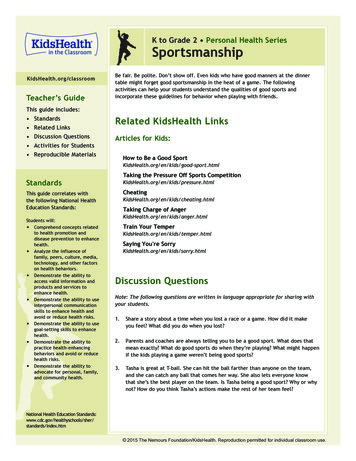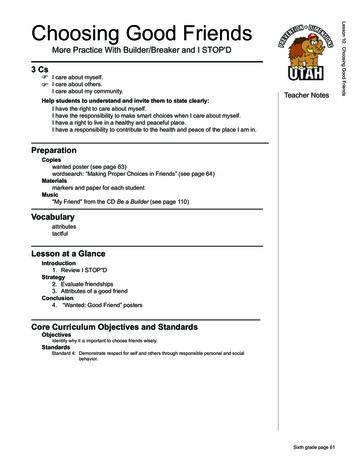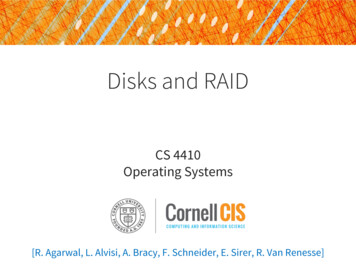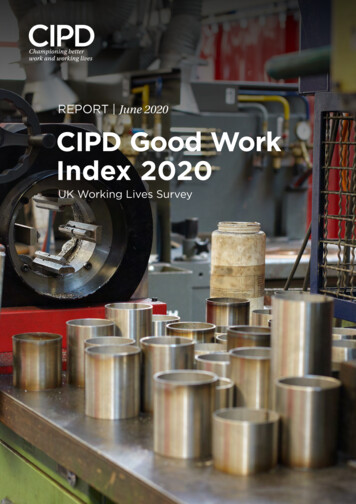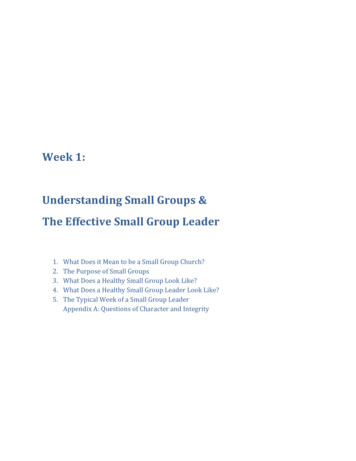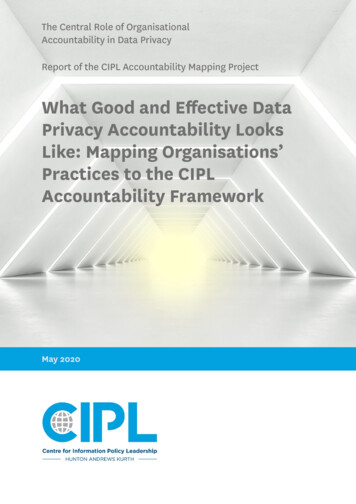
Transcription
The Central Role of OrganisationalAccountability in Data PrivacyReport of the CIPL Accountability Mapping ProjectWhat Good and Effective DataPrivacy Accountability LooksLike: Mapping Organisations’Practices to the CIPLAccountability FrameworkMay 2020
ForewordFor so many years, accountability has been a bit of a holy grail of data privacy law, policy and corporatecompliance. Everybody in the global data privacy community agreed that it was a corner stone of moderndata privacy regulation—delivering effective data privacy and protections for people, driving sustainable andresponsible business practices in an increasingly digital world and delivering more than just compliance witha growing body of national data privacy laws.Accountability has been championed by visionary senior leaders and chief privacy officers in the world’sleading companies. It has also been encouraged by many forward-thinking data privacy regulators and lawmakers in the US, Canada, Europe, Asia-Pacific and Latin America. Yet, there has been no formal consensus,nor consistent evidence of what data privacy accountability means in practice. How do the organisationsactually build and implement data privacy accountability into their business, culture and behaviours througha data privacy management programme? How are they able to operationalise legal norms into risk–basedcontrols, policies, procedures and tools? And, finally, how do these organisations demonstrate data privacyaccountability to their boards, shareholders, regulators and business partners?That is why we at CIPL embarked on a data privacy accountability mapping project. Over six months we havebeen working with 17 leading organisations in different sectors to explore and assess the ways in which theseorganisations truly embedded data privacy accountability in their corporate DNA. Finally, we were able to puta finger on the organisational accountability pulse and get to the bottom of what best in class data privacypractices look like.I am excited and proud to share this report with you. It is the result of years of work by CIPL on all aspects oforganizational accountability. It is also the product of maturing corporate privacy management programmesand of a big shift in how enlightened organisations and their boards approach data privacy as a critical businessissue and enabler of the 4th Industrial Revolution. I am extremely grateful to the chief privacy officers of the 17organisations that took part in our project for their leadership, openness and trailblazing work.I hope their examples and the findings of our report become the inspiration for other organisations and theirsenior leaders in how to build a modern data privacy management programme to address the challenges andopportunities of the digital transformation of our society and economy. I also hope that this report bringsmuch needed consensus and sets shared expectations with data privacy regulators and policy-makersglobally on what good accountability looks like.Bojana BellamyPresident, CIPL
Table ofContentsI. About This Report – MethodologyAnd Objectives.4II. General Findings Applicable To AllAccountable Organisations.6III. Specific Findings And Examples Of EffectiveAccountability. 101.2.3.4.5.6.7.Leadership & Oversight.10Risk Assessment. 15Policies And Procedures.19Transparency. 24Training And Awareness.27Monitoring And Verification. 29Response And Enforcement.32IV. Appendix A. CIPL’s Work On Accountability. 35V. Appendix B. Illustrating Accountability. 373
I. About This Report – MethodologyAnd Objectives1This report (Report) is the result of the Centre for Information Policy Leadership(CIPL)2 Accountability Mapping Project, launched in September 2019. This projectconsisted of interviews and document reviews of mature privacy programmes andaccountability measures of 17 organisations in various industry sectors, sizes andregions—including two SMEs and a university. The main goals of the interviewsand document reviews were to understand how these organisations build andimplement effective data privacy practices, and how these practices map to theCIPL Accountability Framework (see Figure 1 below).Project participants include: Accenture, The Adecco Group, BNP Paribas, Boeing,Cisco Systems, Dropbox, Doctrine, Erasmus University Rotterdam, Google,Mastercard, Novartis, Refinitiv, Symcor, Teleperformance, Twitter, Vodafone andYoti.This report outlines examples of how a sample of organisations of different sectors,geographies and sizes implement effective data privacy management programmes(DPMPs) that reflect the CIPL Accountability Framework. These should not beunderstood as:(i) Mandatory industry standards, but rather as common or specificaccountability-related activities that CIPL has observed. Except for specific andclear legal obligations, organisations have to calibrate the types, volume andgranularity of their accountability activities and controls to the particularities oftheir industry, business model, risk profile and size.(ii) Formal confirmation that the participating organisations meet all thestandards, or that they are compliant with the applicable data privacy laws.Rather, accountability through DPMPs is likely to enable organisations to havethe necessary infrastructure to be able to deliver compliance with data privacylegal and regulatory requirements.4
I. About This Report – Methodology And ObjectivesThe main objective of this Report is to promote organisational accountability in dataprivacy as an essential prerequisite for the 4th Industrial Revolution. In particular,it aims to: Promote accountability as standard market practice and a widely recogniseddue diligence referential in the digital world; Build global consensus on accountability between industry and regulators; Promote accountability as a country and sector agnostic framework and as abridge between different legal regimes; Demonstrate that accountability is a scalable framework that works for bothbig and small organisations; Provide concrete evidence and success stories from organisations thataccountability is demonstrable and enforceable; and Promote accountability as a board-level and a business strategy issue beyondjust legal compliance.The CIPL Accountability Framework is built on seven core elements as describedin Figure 1 below. Section III of this Report outlines examples of accountabilitypractices identified for each of these elements. Section II outlines more generalfindings and common trends that we have observed with all or the majority of theparticipating organisations.Figure 1 – CIPL Accountability Framework – Universal Elements of Accountability5
II. General Findings Applicable To AllAccountable OrganisationsCIPL has worked extensively on accountability (see Appendix A) and has beenadvocating for the uptake and implementation of accountability by organisationsand regulators around the world. Through the accountability mapping exercise, wewere able to test and confirm many of our prior findings, but also observe some newcommon trends among the accountable organisations participating in the projectand test the effectiveness of our CIPL Accountability Framework (see Figure 1 above).Accountability is globally recognised as a key building block for effective data privacyregulation and its corresponding implementation. It means that organisations:a. Take steps such as implementing a comprehensive DPMP to translate data privacylegal requirements into risk-based, concrete, verifiable and enforceable actionsand controls relating to the processing of personal data which are reviewed andadapted over time; andb. Are able to demonstrate the existence and effectiveness of DPMPs internally (e.g.to the board and senior management) and externally (e.g. to privacy enforcementauthorities, individuals, business partners and shareholders).Our general findings and identified common trends concerning accountability are thefollowing:1. All participating organisations view accountability as a journey andan internal change management process to embed data privacy inthe company’s DNA that goes beyond a one-moment-in-time checkboxcompliance exercise. For them, this is not a one-off project that gets deliveredonce and then forgotten about, but an ongoing endeavour driven by continuousrisk assessments and the need for constant improvement. Implementingan accountable DPMP is an iterative and dynamic process that requiresorganisations to adapt constantly to internal and external factors; addressregulatory, legal and technological change; and mitigate new risks. Even themost mature DPMPs have to undergo constant and ongoing adaptation andimprovements.6
II. General Findings Applicable To All Accountable Organisations“Mastercard’s privacy journey started long ago and continues to evolve,with accountability at its core. From making GDPR and privacy bydesign part of our global corporate objectives, to launching our DataResponsibility Principles to guide all our data and AI practices, ourapproach is grounded in a commitment to innovation that places theindividual at the centre of everything we do”.– Caroline Louveaux, Chief Privacy Officer, Mastercard2. Project participants consider the CIPL Accountability Framework asan ideal and well-established architecture to build and organise aneffective DPMP, that translates legal requirements into actionable controls.They also find it to be a useful framework to report and communicateconsistently on their DPMP and efforts, both internally to senior leadersand boards and externally to regulators and investors. Finally, the CIPLAccountability Framework enables them to be systematic and measure theirDPMP and accountability journey over time.3. All the participating organisations and their privacy officers3 recogniseaccountability as a business topic and driver, enabling responsibleinnovation and business sustainability. Accountability helps organisationsanticipate and adapt to new business models, digitalisation and globalisation.It is very much linked to organisations’ business, digital and data strategiesand data-driven innovation. Accountable organisations are more agile.They can better anticipate and react to different business and regulatorychanges, as well as to crisis situations. They already have established policies,procedures, governance and tools that enable them to take proactive steps aswell as directions from top management that drive smooth implementationof such steps. As one of the chief privacy officers (CPOs) said: “Accountabilityis a glue that binds everything together in an organisation, and avoids anycontradictions”.4. Organisations report that accountability results in business benefitsand efficiencies by reducing delays in sales, reducing the number andcost of data breaches, scaling compliance activities and improving overalloperational efficiencies. A recent report by Cisco confirmed that accountableorganisations see higher returns of investment on data privacy.4 This chimeswell with organisations’ senior leaders and boards. They increasingly recognisethe business value of data privacy accountability and position data privacy aspart of a larger data strategy, digital responsibility and trust. Some even linkaccountability to corporate social responsibility.“Companies with higher accountability scores (as assessed usingthe Accountability Wheel5 of the Centre for Information Policy Leadership)experience lower breach costs, shorter sales delays, and higherfinancial returns”.– Cisco 2020 Privacy Benchmarking Stud7
II. General Findings Applicable To All Accountable Organisations5. Processors are also strongly embracing accountability. It enables themto differentiate in the marketplace and build trust in the digital supply chainwith clients who are looking for accountable business partners to fulfil theirown obligations. Processors take steps to be accountable even when they maynot be legally or contractually required to do so. Many see the value of externalcertifications to demonstrate data privacy accountability to their clients andbusiness partners.6. In all the participating organisations, senior leaders recognise theimportance of “tone from the top” and leading by example. Theyarticulate clearly the importance of data privacy and tie it to the strategicbusiness objectives and corporate values. As a consequence, employeesunderstand that protecting personal data and practicing responsible datause are a collective effort and everyone’s responsibility (and not only theresponsibility of privacy officers and legal teams). In turn, this cascadingdownwards of accountability goals and behaviours brings about a real changeof culture in the organisation and increases trustworthiness with customers,clients and business partners.“If you’re doing privacy just for compliance, you’ve already failed.Privacy is an ethical responsibility and business imperative”.– Harvey Jang, Vice President & Chief Privacy Officer, Cisco7. Accountability is sector agnostic and scalable. Our mapping exerciserevealed that organisations of all types, sizes, sectors (including the publicsector), geographical footprints and varying corporate cultures can developand implement an accountable DPMP. The programme, the specific activities(policies, procedures, controls and tools) and the human and financialresources will be different, appropriate to the specific context, risks, goalsand size of each organisation. In particular, while smaller organisations canand do take steps to be accountable, they calibrate measures differentlythan larger, multinational organisations, sometimes with more agility. But theoverall accountability architecture, as suggested by the CIPL AccountabilityFramework, can be the same, irrespective of their industry sector and size.8. All the participating organisations proactively manage privacy risks andadopt a risk-based approach to their DPMP. They build and implementtheir DPMP and activities taking into account the level of risk of their processingoperations to individuals, as well as the risks to their organisations. Riskmanagement enables them to prioritise their accountability measures andmake their programme more effective in practice.8
II. General Findings Applicable To All Accountable Organisations9. Accountability frameworks, such as the CIPL Accountability Framework,are law-agnostic. Organisations report that they use internally similaraccountability frameworks in other areas of corporate compliance, such asanticorruption, anti-money laundering, competition law, export controls andinformation security. This makes it more familiar for senior management andboards, and enables consistent reporting on, and communication concerning,all the corporate risks and focus areas.10. Accountable organisations are driving global convergence in dataprivacy laws and best practices. Accountable organisations build andimplement a single global DPMP with a common set of controls, proceduresand tools, often based on converging norms, to address legal requirementsin all countries where they operate as consistently as possible. This makes iteasier to promote, communicate and monitor a single set of best practices.This is also helpful for national regulators around the globe, as they are ableto align their views and expectations of data privacy compliance activities asthey witness and work with consistent and global accountability frameworks.“Data protection and privacy are core to our business as a professionalservices company. Building our data privacy program around companyvalues, our ethics code and accountability globally, helps us applythe same high standards everywhere—no matter how developedthe law in a country might be”.– Florian Thoma, Senior Director - Global Data Privacy, Accenture9
III. Specific Findings And Examples OfEffective AccountabilityCase Study 1. Data Privacy madeNo.1 corporate priorityThe CEO of an organisation addeddata privacy as the No.1 priority forall its employees in 2020, measuredby specific KPIs. Some teams havebeen directed to spend a minimumof 30% of their annual resourceson data privacy. In the previousyear, 2019, data privacy was made apriority for all engineering teams.Case Study 2. “What is privacyfor you?” – Short videos withexecutivesAn organisation recorded a nonrehearsed, spontaneous shortvideo with the CFO and othersenior executives. They were askedquestions such as “What is privacyfor you?”, “How has privacy changedyour job?”, “Why do you care aboutprivacy?” It has been the most-seenvideo campaign in the history of theorganisation.Case Study 3. Code of Conduct forAI and big data with appropriateoversightAn organisation is drafting an internalcode of conduct for research basedon big data and Artificial Intelligence.It has appointed a privacy andethics board, with an efficient andtransparent procedure for approvalof projects1. Leadership & OversightLeadership and oversight are the anchor of organisational accountability. Theydefine the organisation’s ambition, commitment and governance, so that the DPMPand data privacy procedures and controls are effective and embedded within itsculture.Through the accountability mapping exercise, CIPL has found certain commonfeatures of leadership and oversight in all the participating organisations. Theseinclude organisation leaders making a clear and formalised commitment todata privacy protection; establishing an internal data privacy network thatincludes individuals whose primary responsibility is data privacy; putting in placecomprehensive and effective DPMPs; and ensuring that there is executive-leveloversight of data privacy activities.1.1 Committing from the top (“Tone from the Top”)We have observed that organisations’ boards and senior leaders specificallycommit to data privacy in many different ways, which results in data privacybecoming a mandate for the entire organisation. Commonly and traditionally,boards and senior executives address data privacy as risk and compliance topics.However, increasingly, they also address it as part of a broader business and datastrategy imperative, as well as part of the organisation’s digital trust agenda. Inmany cases, senior leaders link data privacy to the organisation’s code of businesspractices and corporate values, which must be followed by all employees in theirdaily activities.Often, senior leaders require that data privacy be included in the top prioritiesand performance goals of all senior executives, which they then cascade to theirteams and other employees. In some organisations, senior executives are requiredto complete an annual personal certification that they comply with data privacypolicy and programme requirements (among some other key corporate focus andcompliance areas).Our mapping exercise revealed that in all participating organisations, CEOs andsenior leadership communicate regularly on the importance of data privacy to theentire organisation through the intranet, blog posts, videos and emails. In particular,10
III. Specific Findings And Examples Of Effective AccountabilityCase Study 4. CEO ensures dataprivacy is a priority for executivesThe CEO of a business-to-businessorganisation sees accountabilityand data privacy as a personalresponsibility as well as a strategicimperative. She takes efforts tocascade this priority down toexecutives by addressing thesetopics in senior leadership meetings,giving formal statements at theoccasion of the Privacy Day inJanuary, etc. In addition, the budgetallocated to the CPO comes directlyfrom the CEO.Case Study 5. Real decisionmaking power of the CPOA CPO is the “decider” with 51% ofthe vote for decisions concerningdata privacy matters.Case Study 6. The CPO has thoughtleadership in the mandateThe CPO of a multinational businessto-business organisation has25% of her mandate assigned tothought leadership and regulatoryengagement, with a special budget.The CPO sets the priorities forexternal engagements basedon market knowledge, peer andcompetitor activities and regulatoryand legal developments.Case Study 7. The global DPOultimately reports to the CEOIn an organisation, data privacy is theonly area of law that is handled bya global function, led by the globalstatutory DPO with all local privacyleads reporting directly to her. Shereports to the general counsel, whoreports to the CEO.CEOs in these organisations lead by example and are vocal about the importance ofdata privacy, both internally and externally and often on a personal level. They alsoget personally involved in data privacy activities, such as by attending oversightcommittee meetings, reviewing responses to regulatory filings and requestingspecial briefings and reports on privacy.1.2 Individuals responsible for data privacy—privacy officersPrivacy officers are the individuals most frequently responsible for data privacywithin organisations. They are senior leaders responsible for setting data privacystrategy, and for building, implementing and overseeing DPMPs. They oftensit within existing corporate functions (e.g. legal, compliance, risk, products,operations) or, in rarer cases, are a stand-alone function. Privacy officers mayalso have responsibilities for external engagement and representation, includingregulatory engagement with data protection authorities (DPAs), policymakers andstandards bodies.Privacy officers are positioned in the organisation in a manner that allows themto exercise their role effectively and to have authority and impact. They generallyescalate risks and issues to senior management and in some cases to the boardand may even have authority to say no.With data privacy-related matters arising across the entire organisation, privacyofficers often have to work in a cross-functional manner and engage regularly withother business and functional leaders. Depending on the organisational structure,they leverage existing internal steering or oversight committees, or set up specificones, to review issues related to data privacy and ethics.“Privacy officers should aim to build sustainable privacy governanceframeworks or programmes that embed data privacy complianceand make it business as usual”.6– Emma Butler, Data Protection Officer, YotiJust like with the “tone from the top”, many organisations insist on the importanceof “tone from the middle” and privacy officers are a key component of this. Thishelps to make privacy accountability everybody’s responsibility and results in amore effective DPMP.Reporting lines of privacy officers and reporting toolsOrganisations set up different internal reporting lines for privacy officers that areadapted to their business, corporate structure and culture and risk profile. Privacyofficers regularly report into legal, compliance, general secretariat, cyber, IT or risk.In all cases, they are positioned between just one to three levels down from the topmanagement/CEO.11
III. Specific Findings And Examples Of EffectiveI. SampleAccountabilityHeaderCase Study 8. Encouragingemployees to pursue a dataprivacy careerAn organisation has developeda programme to encourageemployees to follow a data privacycareer. Interested employeeswho sign up to the programmereceive privacy training and aregiven opportunities to get certifiedin privacy. They also commit toraising awareness of privacy to thebusiness. The organisation is furtherconsidering sending top employeesto secondments with the UKInformation Commissioners’ Office.Case Study 9. CPO reporting to theboardA CPO provides the board a regularreporting on the risks to individualsand the organisation linked tothe personal data processingoperations. Risks are classifiedand measured quantitatively. Therisk is given a rating from 1 to 5 forboth likelihood and consequence.A “5” in consequence could meanthat significant regulatory fines arepossible, but also that there is apossibility of expensive litigation orsignificant negative impacts on stockprice or company brand. A “5” inlikelihood would mean that a seriousincident is highly probable or nearcertain and a “1” would mean thatcurrent controls would prevent mostserious incidents.In some organisations, privacy officers report on their work directly to the CEO orto oversight boards to provide status updates on the DPMP or escalate strategicdecisions. Some organisations also mandate regular reporting at local and regionalmanagement levels (e.g. to local boards, local managing directors, business orproduct managers).Organisations have adopted and/or developed specific tools to support oversightand reporting. These include visual dashboards, key performance indicators (KPIs),controls, third-party support (such as auditors’ and consultants’ reports). Somemetrics used in these tools include: Percentage of progress on risk assessments; Privacy-related risks and issues identified; Number of data breaches; Number and results of Privacy Impact Assessments (PIAs) or Data ProtectionImpact Assessments (DPIAs); Number and types of privacy complaints and enquiries received; Number of individuals exercising their rights (access, correction, deletion,objection); Numbers and type of regulatory interaction and investigations; and Percentage of completion of mandatory training.Support to privacy officers at local and business levelDue to the number of tasks required of privacy officers, organisations often provideextra support to them at the local/geographical and business levels. This also benefitsthe organisation’s accountability in general, as it cascades the responsibilities andembeds a culture of data privacy more deeply within the organisation.Individuals who support privacy officers locally or at the business level can have: Different titles, such as privacy lead or privacy ambassador; Different levels of seniority; Privacy responsibilities on either full-time or part-time basis; and Different backgrounds (e.g. engineers, lawyers, business, etc.).Their responsibilities include: Acting as the privacy voice to front-line functions and day-to-day operations; Addressing privacy questions; Identifying and resolving privacy issues at a local level; and Escalating privacy risks to privacy officers.12
III. Specific Findings And Examples Of EffectiveI. SampleAccountabilityHeaderCase Study 10. Privacy trainingand certifications provided to allemployeesAn organisation requires all membersof its extended privacy team(including lawyers and engineers)to complete internal basic training,obtain IAPP CIPP certifications andparticipate in a half-day privacyengineering workshop/training.This training is also made availableand optional for all other interestedemployees. The organisationhas sponsored more than 200certifications.Case Study 11. A DPMP helpedan organisation obtain a privacycertificationA business-to-business organisationhas recently obtained a privacycertification for all its activitiesglobally that required it to maintaina global DPMP. The organisation,however, already had a matureaccountability-based DPMP in place.It was able to leverage it and speedup the certification approval.Case Study 12. A look at aninternal ethics and trustcommitteeAn organisation has set upan internal ethics and trustcommittee. The organisationseeks representation from acrossthe business as well as diversitywhen designating members to thiscommittee, which includes theCEO, the DPO and senior managersacross the business. One of theresponsibilities of the committee isto develop an ethics framework.Investing in data privacy talentIn order to drive accountability deeper into the organisation, organisations makeefforts to build and strengthen their internal privacy talent and networks. Thisincludes making data privacy-related positions attractive to employees as part oftalent management and presenting them as a career opportunity. They also providetraining and certification opportunities to employees and enable them to attendprivacy conferences and events and engage with the wider privacy community.“Privacy officers meet regularly to discuss privacy risks, and are betterrecognised and acknowledged by other employees in the organisation.Bringing them together in a team gives them a feeling of belonging and keepsthem motivated that their work is having a positive impact”.– Marlon Domingus, Data Protection Officer, Erasmus University RotterdamPrivacy officers regularly organise internal meetings with their teammates responsiblefor data privacy (e.g. privacy forums, privacy off-sites, privacy fairs, DPO days orannual meetings). During these meetings, they share best practices, define theirannual strategy, assess the state of the DPMP, define common best practices andstandards, issue concrete deliverables applicable throughout the organisation andbuild solutions together to improve it. These can be online or face-to-face, regionalor global gatherings. Some organisations also invite external experts and regulatorsto deliver presentations on hot topics.1.3 Establishing effective Data Privacy Management Programmes(DPMPs) and governanceEffective accountability requires the implementation of DPMPs, which can includethe designation of oversight committees as well as the establishment of appropriateprivacy governance.Implementing DPMPsAll organisations that took part in the CIPL accountability mapping project have putin place comprehensive DPMPs. These DPMPs vary per organisation, but all coverin their own ways all elements of the CIPL Accountability Framework (See Figure 1above). When setting up DPM
organisations truly embedded data privacy accountability in their corporate DNA. Finally, we were able to put a finger on the organisational accountability pulse and get to the bottom of what best in class data privacy practices look like. I am excited and proud to share this report with you.

